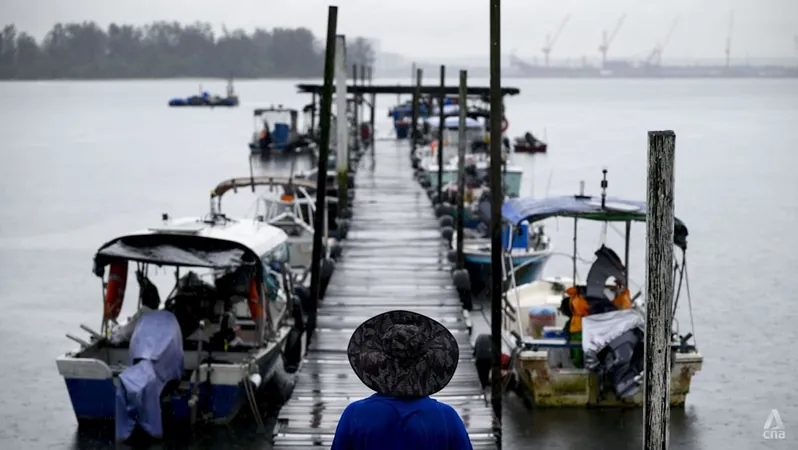
Preserving Tradition: Singapore's Last Fishing Village Fights Against Urbanization
2025-09-02
Author: Arjun
Glimpses of a Vanishing Heritage
Nestled quietly in Singapore's northeast lies the last bastion of traditional fishing life: a kampung-style village clinging to its heritage amid encroaching urbanization. Fisherman Toh Eng Loo, 62, embodies this spirit, bustling through the rustic enclave with a bucket of freshly caught prawns. Here, life operates on the tides of the Johor Strait, feeding a tight-knit community.
A Unique Way of Life
In this quaint settlement, which resembles a forgotten world, about 30 residents rely on rainwater for their needs, powered by generators and solar panels. The experience is far from modern luxuries, with toilets designed to let nature’s tide carry waste away. Yet, this simplicity fosters a strong sense of community, as neighbors know each other well, reminiscing over fresh catches and shared meals.
Rural Charm vs. Urban Sprawl
Surrounded by looming public housing and busy roads, the village is increasingly threatened by modernization. Although development plans have placed the community in limbo since 2003, with talks of a bridge in the works, the pandemic altered timelines and now leaves residents anxiously awaiting updates. "We are just waiting indefinitely," Toh remarks.
Nurturing Connections and Memories
Old friendships run deep here. For Peter Ong, a local painter, buying seafood from Toh feels like a ritual, each catch fresher than any market's. With the village offering some of the best prawns, it’s an essential stop for those who crave the best from the local waters.
Community and Togetherness
Fishing isn't merely a job; it’s a celebration of connection. Mr. Herman Onn, a passionate fisher, dedicates weekends to reliving the camaraderie of past kampung days by sharing his catch with friends. Meanwhile, retirees like Tan Hua Keng flock here to unwind, reminiscing and planting amidst the verdant backdrop. These moments capture the essence of a life slowly slipping away.
A Troubling Future?
Yet the village's existence is challenged by rising costs and the decline of local fishing careers. Many fishermen now supplement their incomes with rideshare jobs, as fishing alone can no longer sustain a household. "It’s simply not sustainable to make a living," Toh laments.
Security and Privacy Concerns
Access to the village is closely monitored, with security preventing unauthorized entries to maintain the community's integrity. Residents seek solitude, guarding their haven against the growing urban encroachment. Even as tourists attempt to visit, they often find themselves turned away.
Hope for Preservation
With potential bridge developments looming, some community members cling to hope that their village can be preserved as a cultural landmark rather than uprooted. Conversations swirl around adaptive reuse and the possibility of educational initiatives to keep the village's story alive. Advocates argue for its integration into the future landscape, emphasizing that it represents more than just land—it’s a piece of Singapore’s heritage.
The Last of Its Kind
As the village navigates its uncertain future, the residents know that time is not on their side. Many older fishermen express concern about younger generations’ disinterest in maintaining their way of life. The village may be on the brink of transformation, but the memories, friendships, and traditions will always linger, echoing through the fading shores.
An Irreplaceable Community
Residents like Toh know they will have to adapt if faced with further changes, perhaps relocating to other jetties. Still, there is a shared love for this place, a deep-rooted connection that goes beyond preservation—it's about keeping a lifestyle and community alive in a rapidly changing world. "If they really want to chase us away, then there’s nothing I can do," Toh reflects, a poignant reminder of the delicate balance between tradition and progress.


 Brasil (PT)
Brasil (PT)
 Canada (EN)
Canada (EN)
 Chile (ES)
Chile (ES)
 Česko (CS)
Česko (CS)
 대한민국 (KO)
대한민국 (KO)
 España (ES)
España (ES)
 France (FR)
France (FR)
 Hong Kong (EN)
Hong Kong (EN)
 Italia (IT)
Italia (IT)
 日本 (JA)
日本 (JA)
 Magyarország (HU)
Magyarország (HU)
 Norge (NO)
Norge (NO)
 Polska (PL)
Polska (PL)
 Schweiz (DE)
Schweiz (DE)
 Singapore (EN)
Singapore (EN)
 Sverige (SV)
Sverige (SV)
 Suomi (FI)
Suomi (FI)
 Türkiye (TR)
Türkiye (TR)
 الإمارات العربية المتحدة (AR)
الإمارات العربية المتحدة (AR)